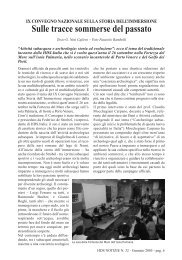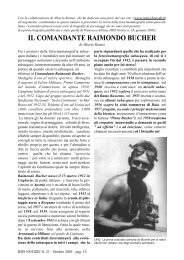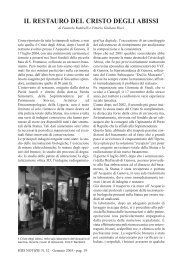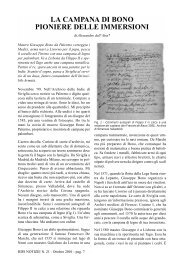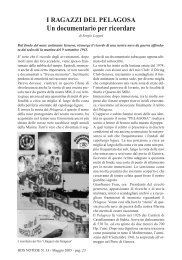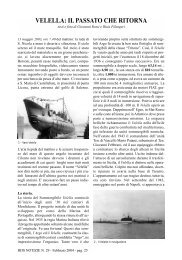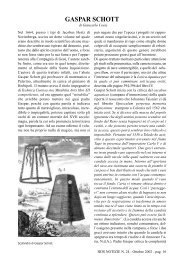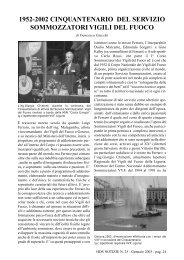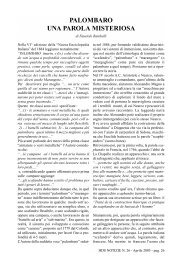Leggi l'intero numero - Historical Diving Society Italia
Leggi l'intero numero - Historical Diving Society Italia
Leggi l'intero numero - Historical Diving Society Italia
Create successful ePaper yourself
Turn your PDF publications into a flip-book with our unique Google optimized e-Paper software.
7 – anni 1928-32 – Gli occhiali in dotazione all’ARO Davis<br />
per l’uscita in emergenza dai sommergibili. Si nota nella<br />
parte bassa del sacco polmone il telo che, tenuto disteso,<br />
avrebbe rallentato la velocità di risalita (da Deep <strong>Diving</strong><br />
and submarine operations, 1935)<br />
7 – 1928-32 – The goggles of which the Davis ARO is<br />
equipped for emergency exit from submarines. It is possible<br />
to notice in the lower part of the lung-sac the cloth<br />
that, kept stretched out, would had slowed down the<br />
speed during ascent (from “Deep diving and submarine<br />
operations”, 1935)<br />
di pressione. Questo è collegato con una manichetta<br />
alla pompa in superficie e con un’altra<br />
manichetta alla maschera granfacciale in gomma<br />
che è del tutto simile ad una maschera antigas<br />
militare, con due vetri rotondi e 5 cinghioli, 4<br />
laterali ed uno frontale. Dalla parte opposta<br />
all’arrivo dell’aria la maschera è dotata di valvola<br />
di scarico. (fig.6).<br />
E’ un vero peccato che Vincent Fernez non sia<br />
quasi mai citato nei testi. E’ infatti evidente ed<br />
indiscutibile che il suo “Fernez” è stato il primo<br />
HDS NOTIZIE N. 28 - Novembre 2003 - pag. 15<br />
1933 – Yves Le Prieur (1885-1963)<br />
The Captain Le Prier was an exceptional man,<br />
the French Navy and Air Force benefited from<br />
his various inventions and the chance and his<br />
inventiveness brought him to take interest in<br />
diving. Many believe him the precursor of<br />
autonomous diving, even if, as we already saw,<br />
it is not really the case. But his moment in<br />
Europe coincides with the appearance of the fins<br />
and with a global ferment in the discovery, in the<br />
years 1930s, of a new sport: “spear fishing”.<br />
In 1925 at the Paris Exposition he sees for the<br />
first time the “Fernez”, of which we have spoken<br />
before, and having used the diving suit<br />
before, he immediately appreciates its innovation<br />
and he matures the idea of making it<br />
autonomous. He makes contacts with the inventor<br />
and the following year he performs dives<br />
with the ARA “Fernez-Le Prieur” in sequence<br />
made of: a small 3 litre, 150 atm Michelin tank<br />
placed on the shoulders, high-pressure pipe, a<br />
pressure adaptor in the front, low-pressure pipe,<br />
mouthpiece with exhaust valve, nose-squeezer,<br />
goggles. Once the tank is opened, air flows continuously<br />
allowing dives of logically only few<br />
minutes.<br />
Considering the trouble of the mouthpiece, the<br />
pain caused by the goggles that under pressure<br />
drive in the eye-sockets, Le Prieur looks for new<br />
solutions. After various tests, in 1993 he realises<br />
a new mask with round glass that covers eyes,<br />
nose and mouth (fig. 8).<br />
He modifies the conformation of his ARO as<br />
well. The tank is placed in the front and the lowpressure<br />
whip that starts from the adaptor fixed<br />
to the tank is directly connected to the mask.<br />
Once the tank is opened, air always flows to the<br />
mask in a continuous way, defogging the glass<br />
and exhausting from the upper edge. The French<br />
Navy adopts this ARA in 1935 (note 4).<br />
(19??) Japanese goggles<br />
Unfortunately we do not have information on<br />
the evolution of the Japanese masks, also if it is<br />
almost certain that Japan was more advance in<br />
respect to Europe. This is demonstrated by the<br />
ARA and the mask “Oghushi” by Rijki<br />
Watanabe and what affirmed by Raymond<br />
Pulvénis in his book of 1940 when he writes that<br />
in 1933 a mask on the type of the one used by<br />
the fisherwomen Ama was built.



